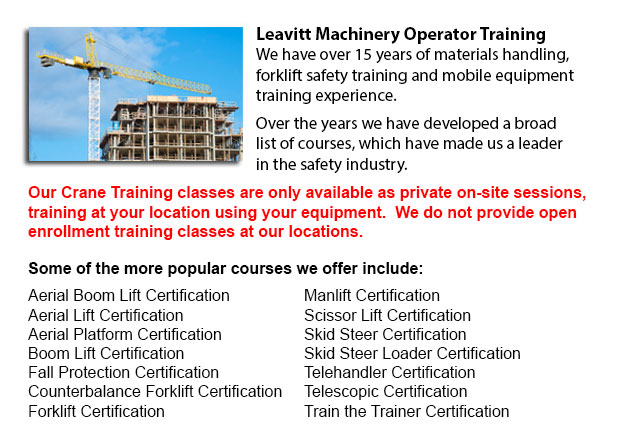
Crane Certification Tukwila - The Crane Certification training program covers content suggested by industry concerning the safe and efficient operation of cranes. People training will learn the following: pre-operational, operational and post operating requirements; how to identify cranes and their component parts; how to determine overall lift capacity; rigging components and inspection/rejection criteria; and needs particular to the work place where the people training will be working.
The requirements that need to be carried out prior to operating a crane such as assigning authority for the pre-operational check; performing the sequential pre-operational check based on the manufacturer's specifications or specifications certified by a professional engineer; checking the log book for comments; checking the work place for hazards and obstacles; inspecting chains, cables, hooks safety latches and crane movement; ensuring the proper functioning of operational controls; and learning how to make certain that the crane's disconnect switch/isolator is working correctly.
Operational requirements consist of identifying roles and responsibilities, and determining the need for a formal lift plan. Individuals training will know how to carry out a hazard assessment related to environmental situations, physical situations and employees. Subject matter comprises determining when to seek competent support, the safest route and destination of loads, and load weight and centre of gravity.
It is essential for individuals training to be able to identify an over-capacity lift, choose proper rigging machinery, know load limitations, and determine a safe place from which to operate. Trainees will review both universal and site-specific crane signals for lifts, and techniques for traveling, lifting and loading. Proper maintenance practice would be covered.
People training would be assessed on their understanding of the need for emergency response procedures for different scenarios like for instance an electrical or mechanical failure. They will be asked to describe shut down and parking procedures for security and safety, to follow tagging and lock out procedures, and to explain the reason why near misses are reported and recorded to the appropriate individual. Log book records should be maintained.
People training would develop knowledge of rigging, particularly, establishing who has authority and responsibility for rigging, identifying various kinds of rigging, knowing load capacity ratings and storage procedures.
The requirements after operation of the crane would be taught as well, learning to enter the defects and deficiencies; and to log the history of maintenance and service records, based on the provincial, federal and state codes requirements.
Site-specific requirements could be included into the safety training program based on the employer's needs.
-
Forklift Train The Trainer Tukwila
Forklift Train The Trainer Tukwila - We provide amongst the best Forklift Training programs within North America, using the latest and most advanced training techniques. Amongst our training courses are Train the Trainer courses, mobile equipment ope... More -
Manlift Safety Training Tukwila
Manlift Safety Training Tukwila - It is vital for competent Manlift operators to be aware of the associated dangers which come with specific types of scissor lifts. They need to be able to operate the scissor lift in a way which protects not just the... More -
Scissor Lift Training Tukwila
Scissor Lift Training Tukwila - While operating a scissor lift, they must be utilized proficiently so as to protect the safety of the other personnel in the workplace and to protect the safety of the machine. Skilled operators are trained to drive th... More -
Crane Operator Certification Tukwila
Crane Operator Certification Tukwila - Crane Operator Certification is a process which permits people to earn a certificate to operate certain kinds of cranes. Certification includes classroom learning, hands-on practice and an ability evaluation. Se... More -
Forklift Operator Certification Tukwila
Forklift Operator Certification Tukwila - Certification for forklifts are required to guarantee the safe utilization of forklifts for those employers in construction, industrial and warehouse environments. The training has to include a method of educ... More -
Boom Lift Ticket Tukwila
Boom Lift Ticket Tukwila - Boom Lifts are a platform lift apparatus which can be raised or lowered to differing heights, making this apparatus a useful tool for various manufacturing uses. There are many distinctive types of Boom Lift consisting of k... More -
Bucket Truck Training Tukwila
Bucket Truck Training Tukwila - The bucket truck training program is a program that is designed to efficiently train qualified operators so they could lessen the chance of personal injury and incident when working in close proximity to or with bucket... More -
Overhead Crane Certification Tukwila
Overhead Crane Certification Tukwila - The overhead crane training certification program is designed to be effective with all those participating regardless of language or literacy restrictions. The program has two parts: a practical training session... More

Forklift Training Tukwila
TOLL FREE: 1-888-254-6157
Tukwila, Washington
forklifttrainingtukwila.com
Email Us
About Us


